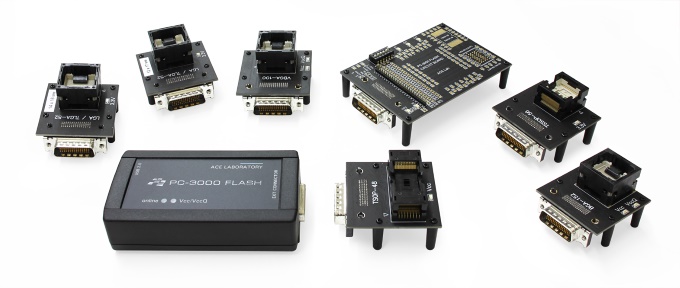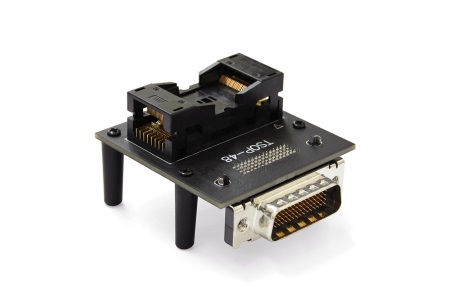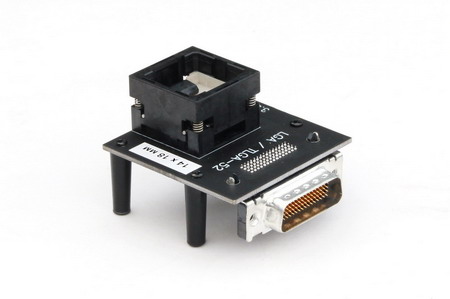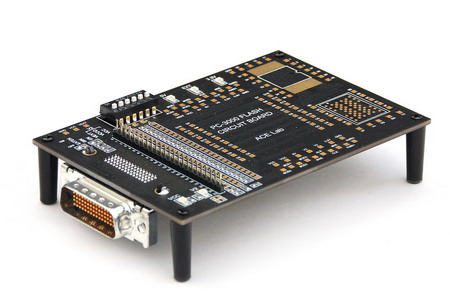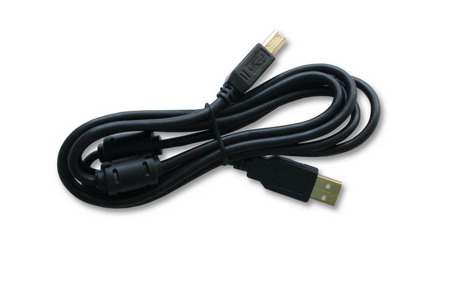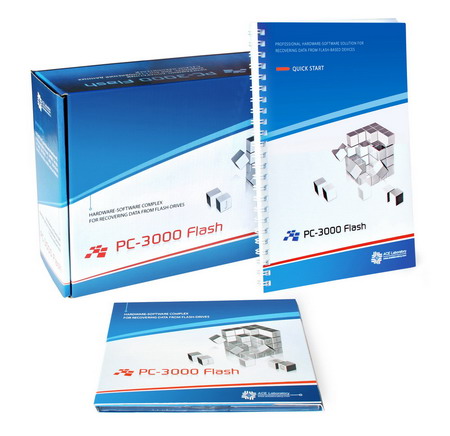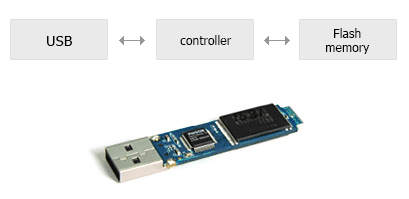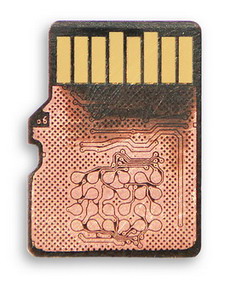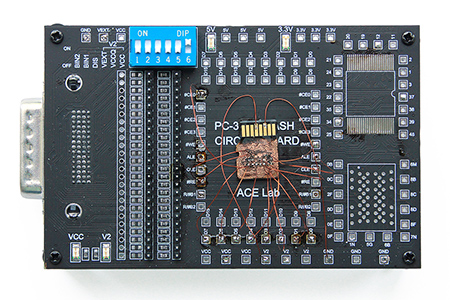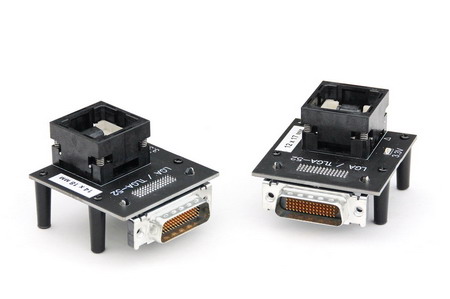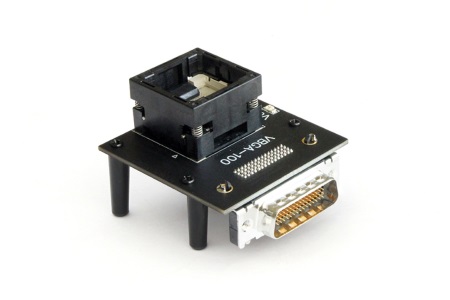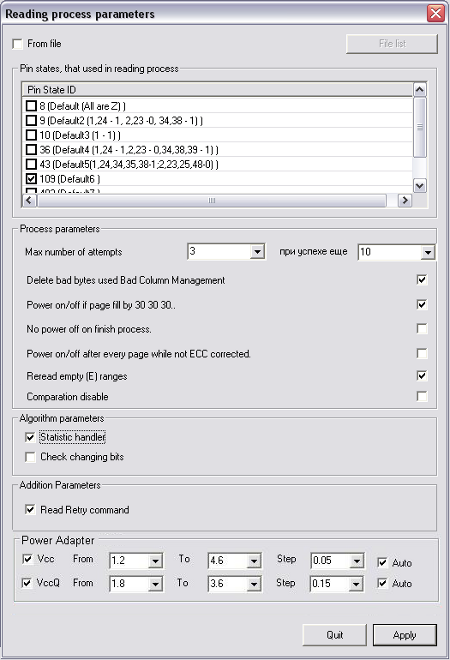PC-3000 Flash System Functioning Principle
In a contemporary NAND-based flash drive we can roughly single out the following parts: interface, controller, memory chip, and internal drive firmware (microcode). The interface can be of any kind - SD, microSD, XD, USB 2.0 or USB 3.0 - and it is a linking unit between the controller and the 'outer world'. The controller processes the incoming data, makes some preparations, converts and mixes the data and prepares it for writing into the memory chip (backwards conversion will take place when the data is read). Memory chips store the received data (a drive may contain one or more than one memory chip). The drive's firmware operates the controller and the interface modes and it monitors the damaged memory cells of the microchips.
The PC-3000 Flash System allows to diagnose a drive and to determine the essence of the problem. All malfunctions of solid-state drives can be divided into two groups:
logical (all units of the device and the microchip are working properly and without fail, but a problem occurs with the damaged file system, with the accidentally deleted files, with the data loss after formatting, etc. ) and
physical (damage to electronic components or to firmware, resulting in a drive failure). Power stabilizers, the controller microchip or the drive's firmware located in the controller (or in the service area of the memory chips) are the most frequent reasons of failure.
To resolve each of these problems, the PC-3000 Flash uses a particular set of its own tools and methods enabling to identify the malfunction and to get access to user data.
Logical problems of a NAND-based drive
If logical malfunction is detected at diagnosis, the drive doesn't require disassembling – it is enough to start the PC-3000 Flash software and use the following modes:
-
Drive analysis enabling to find the existing partitions and to add virtual ones
-
Analysis of the partition data enabling to scan the content of the drive and to find lost files and folders. The mode can be operated basing on the file system, but it can also be started in a configuration when the file system is ignored, and in this case EVERYTHING will be found
-
The mode of RAW recovery allows to recover files and then group the recovered files by types
-
Sector editor. Advanced users, who possess extended knowledge of file systems structure, have an opportunity to fully restore the drive's functionality and its performance
Physical problems of a NAND-based drive
Physical malfunctions of drives occur quite frequently. One the possible causes of malfunctions is the low quality of the drive's electronic components. There can be many other causes, such as incorrect exploitation, etc. In such cases, the controller is the faulty component, whereas the user data remains intact and it is located in the non-volatile memory chips. However, in case of such malfunction, the data can't be read in the standard mode via the device's interface.
To resolve such problems, the PC-3000 Flash System uses a complex unit of software and hardware parts. The System's hardware part makes it possible to read any NAND-memory chips (at first, memory microchip should be unsoldered out of the drive and inserted into the reader of PC-3000 Flash). As soon as a file containing the data from memory chips is obtained, you can further work directly with the data you have read. It is almost impossible to damage the data, and so it is absolutely safe to use the PC-3000 Flash System, as you can go back to the initial dump of each microchip at any time. At the next stage, a set of mathematical tools and methods is used which enables to emulate the operation algorithm of almost any drive controller.
The software component encompasses the following features and functions:
-
A reference base of memory microchips containing information about hundreds of memory microchips
-
A resource base required to most controllers operation
-
About 25 different preparation techniques emulating the controller transformations
-
Around 50 different algorithms of obtaining a full-featured image of the file system
-
View mode for service information
-
Data view mode in bitwise graphic representation
-
Several methods and algorithms to improve the previously built image
-
An integrated compiler enabling you to write your own scripts to work with data
-
Numerous other useful features
-
Many other features and functions
All other modes and tools of the PC-3000 Flash provide a possibility to automatically determine the operation parameters and to apply them. To make the PC-3000 Flash easier to use, three ways of data recovery automation have been implemented:
-
Controller-based recovery, an off-line base of possible steps for recovering user data
-
A comprehensive method of analysis, a mode for mathematical calculation of the likeliest data recovery steps
-
A Global Solution Centre – the website containing a base of over 4,500 solution scripts. When you apply these solutions, you get an opportunity to recover data “in one click”
Hardware features: PC-Flash Reader 4.0 device. NEW!
-
Support a wide range of NAND devices using specialized adapters
-
Completely automatic mode for chip reading and step-by-step manual mode that allows to send commands if requires
-
Wide functionalities to supply voltage control and current restriction (see Technical features)
-
Drivers for 32-bit and 64-bit operating systems
-
Fully controlled and configurable in PC-3000 software
-
Buffered control and the address/data bus outputs
Flash drives in the form of monoliths
A large percentage of contemporary NAND-based flash drives is made up by monolith drives (System on Chip, or Embedded Solution), where the controller, the memory microchips and all the passive elements are placed inside one physical case.
The only external port for this kind of flash drives is the interface port which it is intended for (USB, SD, MS, Micro SD, etc.). If this kind of device has a malfunction and if it is impossible to work through the standard interface, there is a way of getting access to the internal memory chips inside the monolith device, using soldering to special pinouts situated on the circuit board or by direct soldering to the traces of the circuit board. Specifically for such tasks, the PC-3000 Flash System has a Circuit Board adapter, designed to make it more convenient to connect the monolith to the PC-3000 Flash System reader.
The monolith library is regularly updated and it contains information about the soldering pinouts for getting connected to the monoliths' memory chips.
Solutions System for the PC-3000 Flash
Monoliths Library
Supported types of controllers
Supported types of memory microchips











